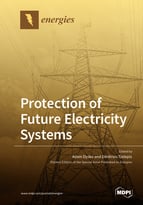Protection of Future Electricity Systems
A special issue of Energies (ISSN 1996-1073). This special issue belongs to the section "F: Electrical Engineering".
Deadline for manuscript submissions: closed (31 December 2020) | Viewed by 23964
Special Issue Editors
Interests: power system protection; distributed generation; system stability and control; microgrids; islanding detection; islanded operation
Special Issues, Collections and Topics in MDPI journals
Interests: power system protection and control; fault location; HVDC transmission; intelligent systems
Special Issues, Collections and Topics in MDPI journals
Special Issue Information
Dear Colleagues,
The generation of electrical energy has been undergoing a series of dramatic changes in recent years, motivated mainly by the commitment to reduce CO2 emissions. We have seen a massive deployment of renewables, an increasing share of DC electricity transmission and distribution, and simultaneous continuing reduction of conventional synchronous generation. This poses a wide range of technical and economic challenges to the existing power systems, including the provision of dependable and secure protection at all voltage levels.
With this Special Issue, we would like to draw special attention to those protective solutions and ideas which can best support future power systems, and thus facilitate the continuing decarbonization of electrical energy generation. Rapid technological advances in many disciplines have created new opportunities for developing solutions which were not possible (or very costly) in the past. The development and increased availability of reliable high-bandwidth communications; high-efficiency real-time processing systems; new signal processing algorithms; and the development of advanced measurement and sensing technologies are but a few examples of possible areas of innovation from which the protective systems could benefit.
Therefore, both conventional and unconventional interdisciplinary solutions are welcome, including adaptive and/or active methods. We also encourage contributions covering systematic, realistic assessment of the existing protection system performance, in particular, evaluating how protection effectiveness can be affected by the current and anticipated changes in electricity generation, transmission, and distribution. The influencing factors could include increased penetration of inverter-connected renewables; the changing nature of loads; new electrical grid architectures; the impact of EV chargers; and many others. Such studies can be based either on real experience in the field or achieved through detailed simulation.
This Issue is open, but not limited, to contributions in the following focus areas:
- Protection in microgrids and islanded systems;
- Islanding detection;
- Protection of HVDC grids;
- Protection of other DC systems, including hybrid AC/DC;
- Protection of convention al and hybrid feeders, including superconducting transmission;
- System integrity and wide area protection, including load shedding;
- Protection performance and testing;
- Fault level estimation, including real-time fault level monitoring;
- Fault location.
Dr. Adam Dyśko
Dr. Dimitrios Tzelepis
Guest Editors
Manuscript Submission Information
Manuscripts should be submitted online at www.mdpi.com by registering and logging in to this website. Once you are registered, click here to go to the submission form. Manuscripts can be submitted until the deadline. All submissions that pass pre-check are peer-reviewed. Accepted papers will be published continuously in the journal (as soon as accepted) and will be listed together on the special issue website. Research articles, review articles as well as short communications are invited. For planned papers, a title and short abstract (about 100 words) can be sent to the Editorial Office for announcement on this website.
Submitted manuscripts should not have been published previously, nor be under consideration for publication elsewhere (except conference proceedings papers). All manuscripts are thoroughly refereed through a single-blind peer-review process. A guide for authors and other relevant information for submission of manuscripts is available on the Instructions for Authors page. Energies is an international peer-reviewed open access semimonthly journal published by MDPI.
Please visit the Instructions for Authors page before submitting a manuscript. The Article Processing Charge (APC) for publication in this open access journal is 2600 CHF (Swiss Francs). Submitted papers should be well formatted and use good English. Authors may use MDPI's English editing service prior to publication or during author revisions.
Keywords
- islanding detection
- microgrids and islanded systems
- HVDC grids
- hybrid AC/DC systems
- superconducting transmission
- hybrid feeders
- active protection
- adaptive protection
- unconventional sensing systems
- fault level estimation
- fault location






